Why Is My Clip on Adobe Preimre Not Uploading the Audio in My Track
Adobe Premiere Pro CC 2019
Premiere Pro is a pop video editing software by Adobe that works on both Windows and on Apple computers. Information technology is comparable to Apple's Concluding Cutting Pro video editing plan, but has go the program of choice for many video producers.
Premiere Pro is a not-subversive editing software, which means nothing you do in the program tin change or overwrite your media files. That said it'due south always good to keep a fill-in of your project and media files. Premier Pro is taught in three of our workshops. For a hands-on video editing experience bring together Premiere Pro for Intermediate Video Editors or Advanced Video Editing.
Creating a New Projection
Each video you lot create in Premiere should start by creating a new projection.
The project file will save all your edits and changes you've made. It'southward saved equally a split up .prproj file that can exist opened simply with Premiere Pro.
The project file will contain references to the dissimilar media files you apply to build your movie and the sequences on which yous arrange your video clips, add together sound tracks, transitions, titles, etc.
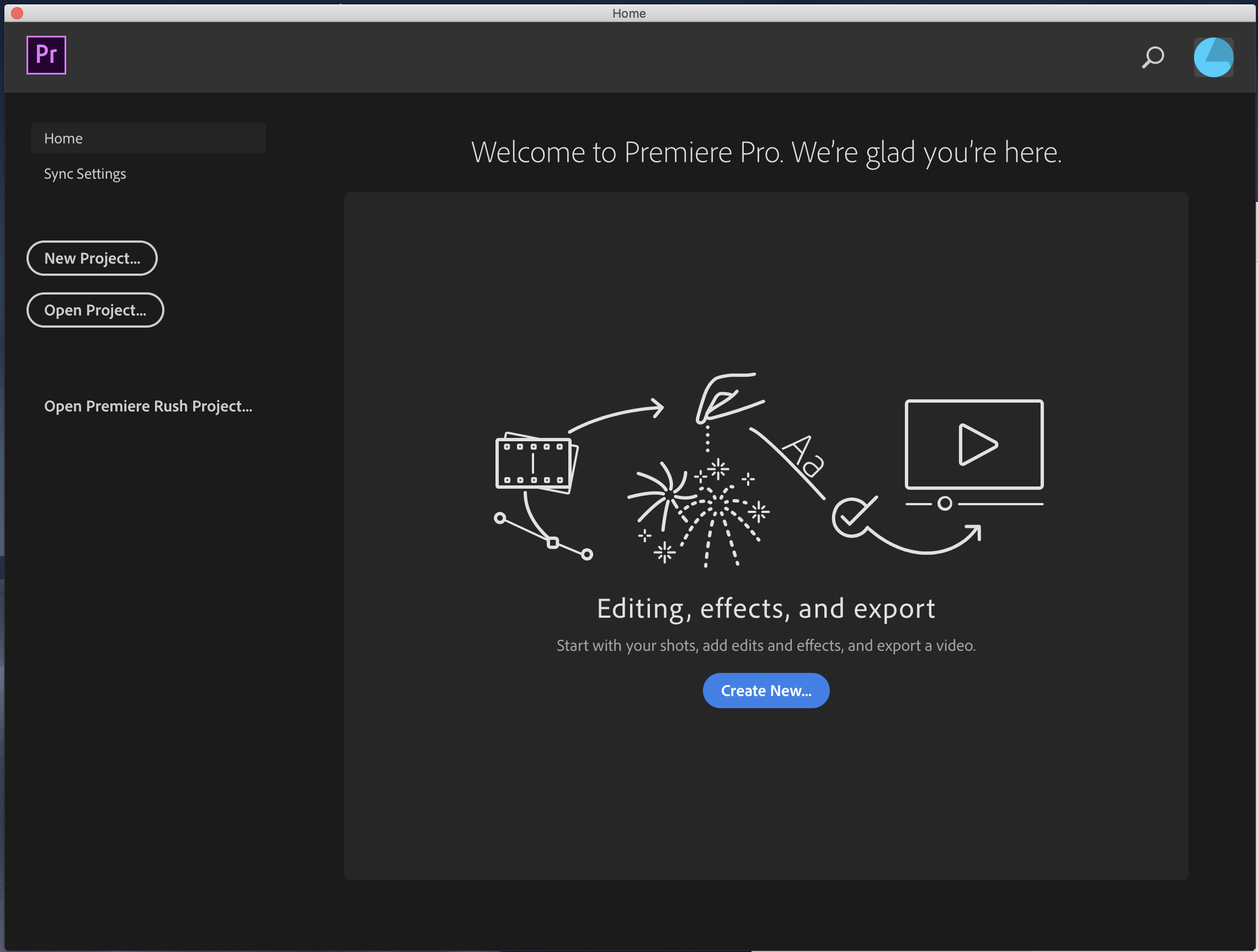
When you launch Adobe Premiere Pro, a new window will appear. Click the New Project push, located on the left side of the window.
This volition open a new window where you can define the basic settings of your project, including the filename and location where the project file volition be saved.
In the New Project dialog box, Proper noun is what you lot'll phone call the project file, and Location is where the project will be created.
When working in Premiere, it'due south all-time to go on both your footage and project file together on an external hard drive. And so on your external hard bulldoze, make a new binder for your project, and utilize Browse to save your project file in that new folder.
You shouldn't demand to change whatever of the other settings on this page, but before you click OK , y'all should check the Scratch Deejay settings.
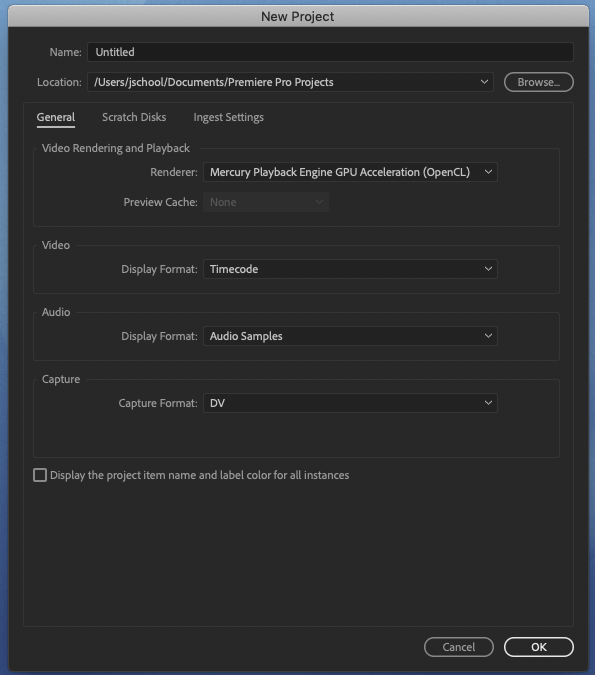
Setting the Scratch Disks
Click on the Scratch Disks tab at the top of the New Projection dialog box.
The scratch disk is the location on your computer where Premiere Pro CC 2019 will store media and other files related to your projection.
Past default the Scratch Disk volition be set up to the same folder that you lot set every bit the location for your new projection. We recommend setting it to the same location, unless you have multiple difficult drives.
IF You ARE WORKING ON A Estimator WITH 3 OR More than HARD DRIVES then yous tin improve operation by setting "video previews" and "audio previews" to that third bulldoze. If you simply have 1 or 2 drives (your computer, and an external hard bulldoze), you can ignore this, but for the curious, the ideal deejay setup according to Adobe is as follows.

Afterward scratch disks, you can cheque out the Ingest Settings. Nosotros won't change any of these settings correct now, but we'll come dorsum to them later when nosotros start importing our media files. All of these settings can be changed subsequently you've started your project besides, if needed.
After verifying the ingest settings, click OK .
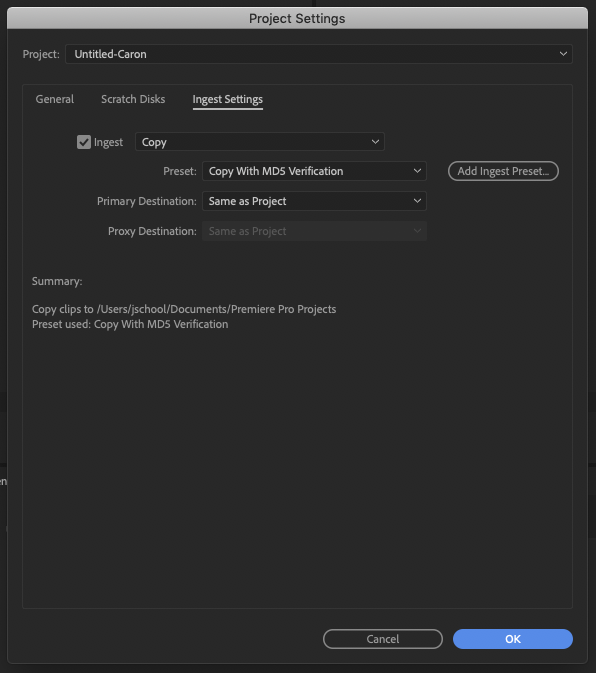
Editing Workspace
Subsequently you create a new project or re-open an existing project, the main workspace for Adobe Premiere will open on your screen. It is divided into four sections or panes:
- Workspaces – This bar at the summit shows the different workspaces available in Premiere. A workspace is just a preset for how the dissimilar panes are arranged. By default, Premiere should open in the Editing workspace. This is the workspace we will be focusing on. If you ever accidentally shut or can't find a window, right click the iii horizontal lines next to Editing in the tiptop bar, and click Reset to Saved Layout.
- Project – This shows the media files you lot accept imported into your project, too as your sequences. Within this window, there are also a number of tabs you can navigate through to access your media more easily. Two of the chief tabs we volition be using are Media Browser, and Effects. Media Browser shows files on your reckoner or external hard bulldoze that you lot can import into Premiere. Effects contains different filters and transitions you tin utilize when editing your video.
- Source – The Source pane is used to preview video clips selected from the project window. Double click a video file from the Project pane to view it in the Source pane. You tin can drag and drop video files from the Source or Project pane into the Timeline to begin editing. I of the master tabs within the Source pane is Effect Controls, where you can adjust furnishings y'all've added to your source video.
- Timeline – This is where you assemble your clips in a sequence, along with transitions, text boxes, sound tracks, etc. Until y'all create a sequence, this section will be blank. The default position is the lower right of the screen.
- Program – This pane is where you tin can see a preview of the sequence you take open in the Timeline. This is the preview of your edit in progress.
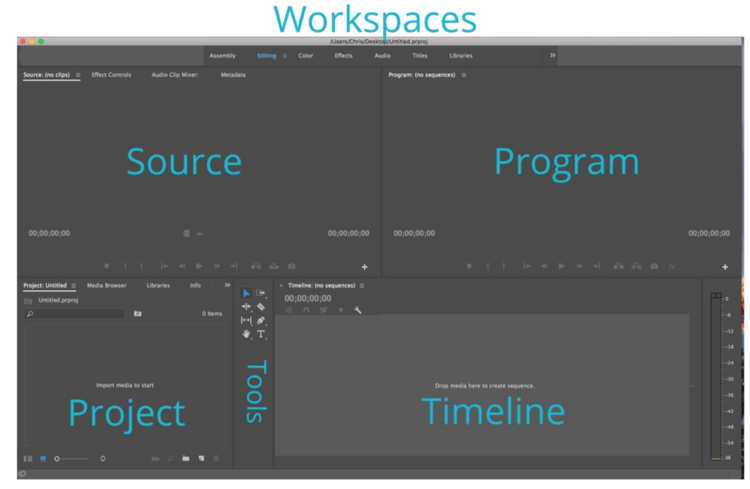
To change the layout of your workspace panes, click the Window button in the vertical bar at the top of the screen. 'Workspaces' should exist the first option in the menu. Hover over it to display the available pre-selected workspace panes, and select whichever you adopt. Nosotros recommend using the Editing layout.
Any panel can be resized by clicking and dragging at the margins between panes, or moved around the screen by clicking and dragging on the name of the pane.
Preferences
You can change a number of setting preferences in Premiere, such as doing more than frequent automatic saves of your project or changing the default settings for how audio from your camera is converted into different types of audio tracks in Premiere.
To change the preferences on a Mac, in the horizontal menu at the top select Premiere Pro > Preferences and select the setting you lot want to change.
On a PC, the same card is available from Edit > Preferences
Auto Save
We recommend adjusting your Motorcar Save preferences to Automatically Salvage Every v minutes.
To do this, select Premiere Pro from the horizontal carte at the meridian of the screen. Hover over Preferences , and click Machine Salve from the drop-downward bill of fare.
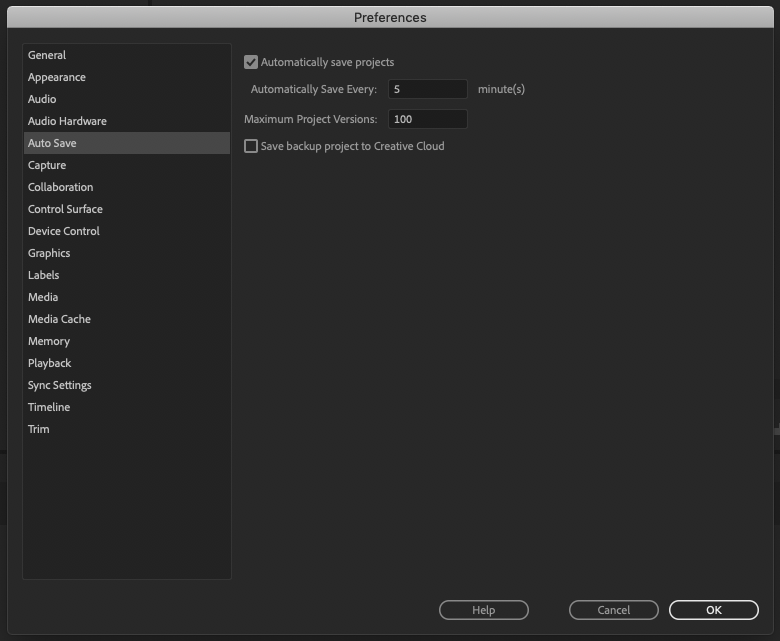
Make sure you have selected the checkbox next to Automatically relieve projects .
In the text field next to Automatically Save Every: enter v minutes.
In the text field next to Maximum Project Versions: enter 100.
This will automatically salvage your project more than frequently, and go on a longer record of old versions of your project.
You lot can choose where Premiere Pro CC 2019 volition shop your auto saved files past setting your Scratch Disks. Hover over File in the horizontal menu at the superlative of the screen, become to Project Settings and click Scratch Disks . A new window called Project Settings will appear. Under Project Auto Save , you tin cull where the auto saved files will be stored.
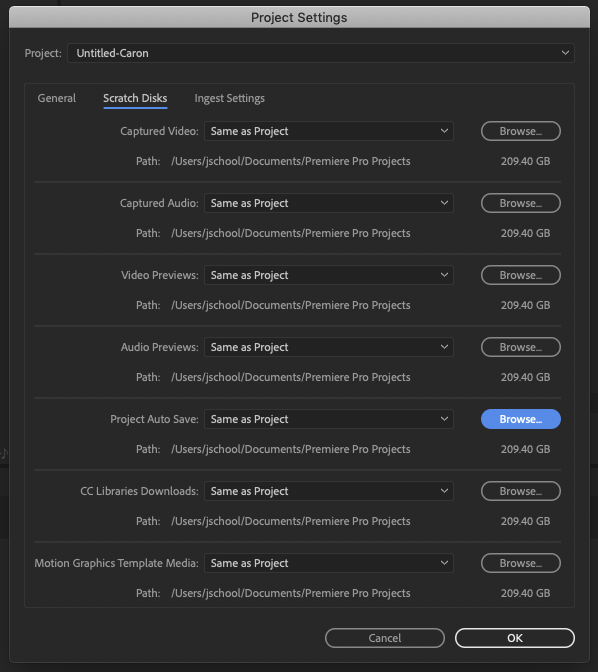
Copying Video Camera Files
Before we edit video you've shot, we need to copy it from your camera's retentivity carte to the computer or external hard drive.
The easiest style to do this is to connect your retention carte du jour to your computer using a card reader, and drag and drop the contents into a folder that will contain both your project file and video files onto the computer or external hard drive.
Of import annotation : It's best to elevate the entire contents of the menu onto your computer. DSLR cameras like Canon and Nikon may take individual .mp4 files that y'all can copy one by one, but for many cameras, especially from Panasonic and Sony you lot need to drag the entire folder on the carte. This binder is probably chosen "Private" and will incorporate another folder called AVCHD or XAVC the video files. It's important to go on these folders together because they also contain related files such every bit metadata files that Premiere will need to open the videos. Y'all should not edit the AVCHD folder or any files within this folder, or you risk corrupting the video footage.

Copying your footage to your calculator or external hard drive volition make the video files accessible to Premiere for import via the Media Browser, and allow yous eject the memory card without breaking Premiere's connection to the video files.
Importing
Information technology is necessary to import your media into Premiere so you can begin editing.
Click File > Import from the horizontal bill of fare at the summit of the screen. A finder window will open, and y'all can select the folder or individual files you lot desire to import.
 You can also use the Media Browser pane in the lower left side of the editing workspace to navigate your calculator and select media to import. The Media Browser functions similarly to Finder or Explorer, just is built into Premiere. You can view the files that are available on your computer or external difficult drive and import them into Premiere.
You can also use the Media Browser pane in the lower left side of the editing workspace to navigate your calculator and select media to import. The Media Browser functions similarly to Finder or Explorer, just is built into Premiere. You can view the files that are available on your computer or external difficult drive and import them into Premiere.
You'll meet the file directory for your hard drive displayed on the left. Navigate to the binder that has a file you want to employ in your picture, and you'll come across the file displayed on the right. Video files will appear as icons showing the first scene from the clip.
Make sure you click the icon view button at the lesser of the Media Browser to brandish your video and photos as icons. You lot can also adjust the slider at the bottom to increase the size of the icons, and click on the three horizontal lines to sort by name, filetype, etc.
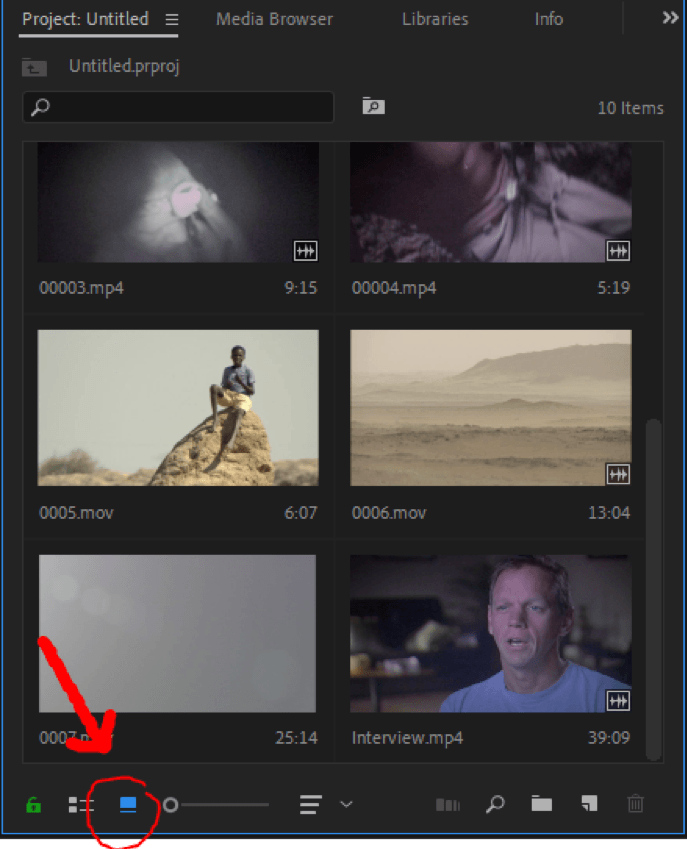 You can preview a prune to make sure it'south ane you lot want to import past selecting the prune and using the small scrubber bar to scan through the clip.
You can preview a prune to make sure it'south ane you lot want to import past selecting the prune and using the small scrubber bar to scan through the clip.
Press the tilde central ( ~ ) on the keyboard while the Media Browser is selected to view this projection pane in fullscreen view. This, in conjunction with zooming on thumbnail view, offers an easy way to scrub through your videos and preview your clips.
Double click on a file to preview it in the Source pane, located straight above the Projection pane. This does not import the file, but allows you to play the prune, and scrub through it in a larger view.
To import a file, correct-click on a file and select Import from the drop-down menu. Premiere Pro CC 2019 will import the file and it will appear in the Projection pane.
Ingesting
Y'all can besides copy files from a media bill of fare to your computer and import them into Premiere in 1 action using the Media Browser. This volition re-create media from your card to your computer, and import all at in one case. Adobe Media Encoder must be installed to import files this mode.
To starting time, in the top bar of the Media Browser, select the checkbox labeled Ingest .
And so click the wrench next to the Ingest checkbox to verify your settings. The Project Settings window will open to the tab chosen Ingest Settings.
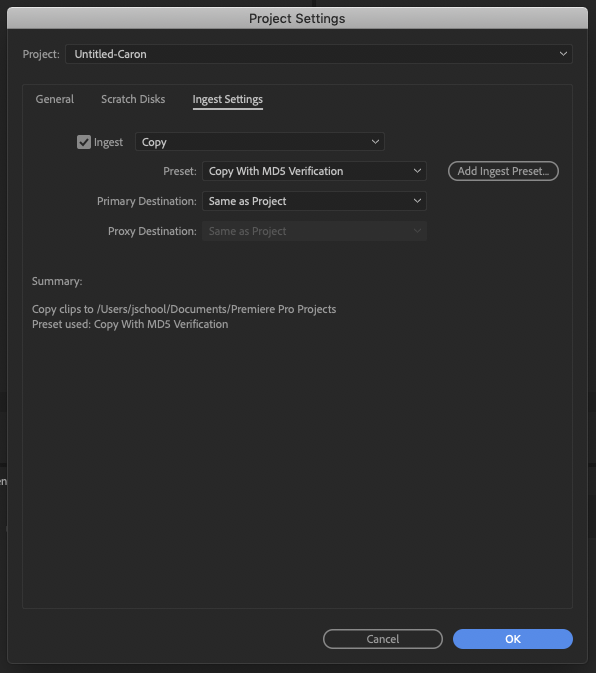
Copy : means that a re-create of the files will be made.
Preset: MD5 verification is a fancy mode of saying Premiere will double check to make sure everything copied without errors.
Primary Destination: Defines the location where the files will be copied. By default, the files volition be placed in the same binder every bit your project file.

Click OK to relieve your settings.
Navigate to locate your carte using the Media Browser tab. Your media card should exist under Local Drives. Y'all tin can toggle the arrow to find the specific card yous want to import files from. Correct click on the file or folder you lot wish to import, and select Import from the menu options. The media files will be copied from the card to your project file, and imported into your project.
Another program called Adobe Media Encoder will open and bear witness you lot a progress bar as the files are being copied, simply yous can ignore this and first editing immediately.

Undoing changes
If you make a mistake while editing your video y'all can use Premiere'due south Undo part to return to earlier versions of your project.
In that location are multiple ways to use the Undo office. Navigate to the horizontal menu bar at the peak of the folio, right click Edit and select Disengage from the bill of fare.
Alternatively, if you are using a Mac, y'all can use a keyboard shortcut and simultaneously press Control + Z . If y'all are using a PC, press CTRL + Z .
Previewing Your Clips
In gild to edit the footage you imported, navigate out of the Media Browser, to the Project tab in the Project pane.
Double bank check that you are working in the Project pane and non the Media Browser. Clips in either window tin can be previewed in like means (like scrubbing through the footage), but information technology'southward only the Project pane that shows you the imported media that's fix to edit.

You can change how y'all view your footage- in a listing or as icons yous can scrub through -by selecting between two buttons in the bottom left of the Projection pane. You tin view clips in the Source pane for a larger preview. Double click on a prune, or click and drag it onto the source monitor to preview.

Once a clip has been loaded in the Source pane, you can use the buttons on the lesser, or the infinite bar on your keyboard to playback or pause the video. The blue pointer is called the Playhead , and shows your position in the video. You can drag it left or right to scrub frontwards or backward in the clip.
You lot can command playback with the keys J , One thousand and L . J will rewind, 1000 will pause, and Fifty volition play the clip forrad. Clicking J or L multiple times volition speed upwardly playback forrad or backwards.
Creating a Sequence
Before you start editing, you need to create a sequence. A sequence is a container for all of your edits. Sequences are organized and accessed in the Project pane and edited in the Timeline. Yous tin can have multiple sequences in 1 project, or do all of your editing inside one sequence, it just depends on how you work.
To create a new sequence, navigate to the horizontal menu at the top of the screen. Click File > New > Sequence . Alternatively, yous can utilise the shortcut Command + N on a Mac, or CTRL + N on a PC.
Once you've created the sequence, a New Sequence window will open. Here, you tin choose settings for your project's sequence, which will be applied to the video you are creating.
You tin change settings here to match the video format for the camera you used for this project. Y'all so can save the changes as a custom setting to reuse later (this is helpful if you lot're repeatedly using the same video camera). For example, the main video photographic camera we use at Berkeley AMI is the Sony X70.

In the Sequence Presets tab, navigate to the XDCAMHD 422 folder, nether Available Presets. Within this binder, open the 1080p folder, and select XDCAM HD422 1080p24 . This setting matches the resolution and frame rate we employ with the Sony x70 photographic camera.
If y'all are shooting on a Nikon or Canon, you'll want to use the Digital SLR setting.
To create custom settings, open the Settings tab, located to the right of the Sequence Presets tab. Click the Save Preset push in the bottom left of the window. A new window volition open up, prompting you to name your preset. Name the preset and click OK . Your preset will exist available in the Sequence Presets tab, within the Custom folder at the bottom of the listing of Available Presets.
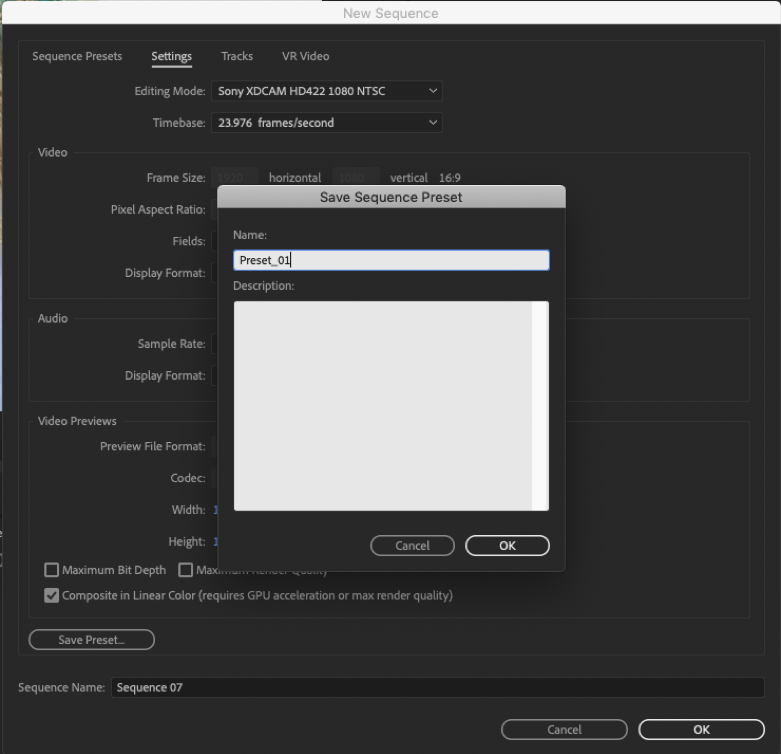
You can use your custom preset for future projects where yous are editing video from the same camera.
If you're unsure of the video settings on your camera, Premiere tin can automatically match the sequence settings for you. Premiere Pro CC 2019 will practice this automatically when you drag a video prune from your Projection pane into the Timeline.
Later, when yous drag and drop a prune into the Timeline, a dialog box will appear asking if you want to Change sequence to match the clip'due south settings . To exercise then, select Change sequence settings , and the settings will be adapted to match those of your video prune.

NOTE: If you copy and paste a prune into the Timeline, y'all may not get this warning. It may only appear after you drag a clip into the Timeline from the project window or source monitor.
Moving Clips to the Timeline
Yous can add a clip to a sequence in the Timeline by dragging it from Source pane on the top left of the screen, down to the Timeline pane on the lower correct. Alternatively, yous tin drag and driblet video footage from the Project pane directly into the timeline.

Drag the prune to the V1 video track on the timeline and release.

If in that location is sound with the prune you're moving to the timeline, that volition automatically be added as one or two new tracks of sound located on A1 and A2 below the video runway.
If necessary, yous can elevate only the audio portion of a clip to the timeline. Drag the icon that looks like an sound waveform, which appears just below the preview on the Source pane, to the sound tracks in the timeline.

You lot can besides elevate but the video portion (without audio) to the timeline. Catch the icons just beneath the preview on the Source pane that appears like a motion-picture show strip, and drag it to the video track of the timeline.
Yous can also highlight a portion of the video as you lot preview it in the Source pane, to drag a pick into the timeline, rather than an entire video clip.
Click where y'all would like to brainstorm the selection using the blueish playhead. Choose the selection using the open subclass tool {, or clicking I on your keyboard. Scrub forward in your video preview to your chosen endpoint and click the closed bracket tool }, or press O on your keyboard. The area you accept selected volition be highlighted in the Source pane. Drag and drop the selection into the Timeline pane to edit.

Working with the Timeline
The timeline is where you will do your editing and build your last video.
Video clips appear as horizontal confined in the timeline. Those in the upper half (Lines marked V1, V2, V3 etc.) are video content. Those in the lower half (A1, A2, A3 etc) are sound content.

The thin vertical blue line is the playhead, and it shows your position in the timeline. When the playhead is over a video clip, the video will announced in the programme pane above. If yous take multiple tracks or clips in the timeline, the playhead will view them from the top-down. For example, one video track will cover some other. Remember of all your tracks every bit if they're stacked up, and the playhead is viewing them from above.

You lot can merely view the top video clip in the Program pane.
You can move the playhead by dragging it right or left, or you can press the spacebar on your keyboard and employ the keys J,K, and L to navigate. They play backwards, pause, and forward, respectively.
You tin can also zoom in or out in time on the timeline using the + and – keys, or by clicking and dragging the circles on the horizontal bar under the timeline from left to right. Zooming in and out on the clip allows yous to view the seconds or minutes more closely, and edit your footage more than precisely.
Zoomed Out:

Zoomed In: This is the same clip equally higher up, but nosotros're seeing only a few seconds of it beneath.

Editing Clips in the Timeline
You can move video clips around in the timeline by clicking and dragging them up, down, left or right.

You can shorten clips by clicking on the border of a clip and dragging it in. When y'all hover your cursor over the clip, a crimson arrow will announced. Click and drag inward to shorten the prune to the desired length.

You can also lengthen a clip by clicking on the edge and dragging it out to the right.
If you take a clip with both video and audio tracks, and you want to change one track without affecting the other (such as deleting the sound track), yous tin unlink them.

To separate sound from video, click the Linked Selection push, which has an image of a mouse cursor over ii confined. When the push is highlighted blue, your sound and video are linked within the clip, when it's white, the pick is unlinked. Alternatively, y'all can correct click on the clip and select Unlink in the drop-downward menu. You lot now can move the video and audio rails clips independently of each other.
By holding Choice or Alt , you can likewise make any of your edits merely target the clip you're clicking on. For instance, holding Alt volition allow you click and simply select one audio track from a linked pair.
By default, the Timeline is set upwards and then that next clips "snap" to each other, which makes it easy to marshal them without having one clip accidentally overlap the other or leaving empty space between clips.

If needed, you can turn off snapping by clicking on the Snap icon, which is in the meridian left of the Timeline, to a higher place the labels for the video tracks. The Snap icon looks like a U-shaped magnet, and should be highlighted blue if it is on, and white when it is turned off. If y'all pass your mouse cursor over the icon the discussion Snap will appear. You lot can also click S on your keyboard to plow information technology on and off.
If you want to delete a prune on the Timeline, select the desired clip and printing Delete on your keyboard.
Razor Tool for Splitting or Deleting Part of a Prune
If you want to carve up a video or audio prune in ii, or remove a segment in the middle of a clip (such as eliminating a audio gap in your audio), you tin can use the Razor tool to dissever or piece out a segment of the clip.
The razor tools is ideal for editing longer clips, like interview segments. You lot tin can bring the entire clip into the timeline and use the razor tool to make cuts to the clip.
 It's chosen a razor because in the traditional picture editing procedure a record was literally sliced with a razor blade to remove unwanted pieces of the picture or rearrange segments of a motion picture.
It's chosen a razor because in the traditional picture editing procedure a record was literally sliced with a razor blade to remove unwanted pieces of the picture or rearrange segments of a motion picture.
To practise these cuts in Premiere Pro 2019, in the Tool palette click on the Razor tool, which looks similar a razor blade. For a shortcut, you lot can as well press C on your keyboard. Your cursor will change to a minor razor icon while you are using this tool.
Click on the video prune at the point where you desire to cut it. Or cut the clip multiple times to create a segment in the middle that yous tin remove. Then click on the Option tool in the tool palette (the keyboard shortcut is the V key) so y'all can select one of the segments to move or delete it. Delete the selection you've made by clicking information technology and pressing Delete on your keyboard.
Editing Clips in the Source Pane
Y'all can brand shorter selections from video clips while they are displayed in the Source pane to simplify editing earlier you lot bring clips into the timeline. You can select only the best parts of the clip to bring into the timeline, and then you can edit out whatsoever unnecessary footage.
In the Project pane, double click on the clip y'all want to edit to brandish it in the Source pane.
Play the clip using the play controls at the lesser of the Source pane, or past pressing the spacebar on your keyboard (printing the spacebar once to play and and so once again to pause the clip).

You also tin can use J, Grand, L, and the spacebar on your keyboard to play the clip – L to speed up, J to rewind, Thou to break, and the spacebar to play the clip at normal speed and break.
You can also scrub through a clip by clicking on the bluish playhead simply under the clip and dragging it to the right or left.
Select the part of the clip y'all desire to move to the timeline by setting in and out points on the prune while it's in the Source pane. Move the playhead to the point where you want your clip to offset, and press I on your keyboard, or clicking the { left bracket button, to gear up the in betoken. At the point where you desire your clip to end, printing O on your keyboard, or click the } right bracket button, to prepare the out point. You will see a highlighted blue expanse in the scrubber bar below the prune showing the selected area.

The in and out points tin can be adjusted by clicking and dragging on either border of the bluish department of the scrub bar.
Once you've prepare the section of the clip you lot want in the In and Out points, y'all're set to copy the clip to the Timeline.
Overwrite and Insert Edits
If you want to put a new clip at a betoken in the timeline where it will overlap with an existing clip, you lot have 2 options:
- Overwrite Edit : the portion of the new prune that overlaps the onetime clip will replace the contents of the old clip. Thus you might take function of a video interview with someone that you want to overwrite with some "b-roll" footage of what the person is talking about.
- Insert Edit : the quondam clip will exist split up at the insertion point for the new clip and function of the old clip will be moved to the right on the Timeline to make room for the new clip. You might want to dissever up a video clip of a scene by inserting a new scene in the middle of information technology.
You can do Overwrite or Insert edits by moving a new clip to the aforementioned track in the Timeline equally the existing clip or by putting the new clip on a new video track higher up the existing clip.
If y'all practice an Insert edit on a new track, it will still split up the original clip on the track beneath. If you do an Overwrite edit on a new track, information technology will not change the original clip on the track below, but you lot won't see that video because the new video is on a track in a higher place it.
The Overwrite edit is the default in Premiere Pro 2019. When you drag a clip to the timeline, Premiere will automatically overwrite the overlapping portion of the existing clip with the new clip. This will be indicated by an arrow pointing downwardly.

To do an Insert edit , press and hold down the Command cardinal on the Mac keyboard and then click and elevate the clip to the timeline. That will split the existing clip on the Timeline and motility the rest of the clip further to the correct on the timeline to brand room for the new prune. This is indicated by an arrow pointing to the right.

In the Project pane, click to highlight the video clip you want to insert into the timeline. Beneath are the buttons for Insert and Overwrite . They also have keyboard shortcuts: , and .

If you use the keyboard shortcuts or the buttons, Premiere Pro 2019 volition place the clip where your playhead (the vertical blue line) is located in your timeline.
Rail Targeting
You lot tin can control where clips become when you add them from the source monitor, or when yous copy and paste them.
The rows with blueish highlighted letters, to the left side of the Timeline pane, control where video clips are placed. The far left side refers to what is in your source window. It'south chosen source targeting.
The below image is saying I accept a clip loaded that has one video track and ii sound tracks, and that if I drag it into the timeline, it would be placed on video runway V1 and audio tracks A1 and A2. You tin can move these targets around to change where clips will be placed.

In the beneath paradigm you can run into that the source targeting has been moved to video rails V3 and sound tracks A3 and A4. When clips are added from the source window, this is where they will be placed.

The right column of highlighted boxes is also "targeting," but specifically for when you copy and paste clips. This is chosen Runway Targeting. And so if you copy a clip, by default it will paste into video track V1, but you could change that past clicking the highlighted video and audio tracks to plow targeting on or off.

By default, clips will paste into the innermost targeted track. And then right now, if I copied and pasted a clip, it would announced in video track V3 and sound tracks A3 and A4.
Working with Multiple Tracks
Past default, Premiere Pro 2019 provides 3 tracks of video and vi tracks of audio in the timeline. You can create boosted tracks by dragging clips above or below the outermost tracks.
You lot can besides create boosted tracks in the horizontal carte du jour at the superlative of the screen. Click Sequence > Add together Tracks.

A new window will appear called Add Tracks . Enter the number of video and audio tracks you would similar to add, and choose where they will exist placed. Click OK to add the tracks.
If y'all have multiple tracks of video, whatever video is on the top rails in the timeline will be shown when the sequence is played, and any other video clips underneath will non exist seen.
If you have multiple audio tracks then all the sound will play simultaneously no thing which is above or below the others on the timeline.
To hide the video from a detail track in the timeline:
- Plow off the video for a particular track in the timeline by clicking on the eye icon button to the far left of the rails to hibernate it. The centre icon is labeled Toggle Rails Output, when you hover over information technology. After clicking the eye icon, information technology will be highlighted blue with a cross through it. Click it again to view the footage on the track.

To turn off audio for a particular track in the timeline:
- Turn off the audio for a detail track in the timeline by clicking on the Thou push to the far left of the track. The push button will turn green when the track is muted.
- To only play the audio from one specific runway, click the Due south icon (for Solo). The push button will turn yellow when the track is "Soloed."

Markers
You tin set markers on clips in the Source, Timeline or Programme panes to help keep track of clips when editing video and audio.
The marking creates a snap-betoken on a clip or the timeline that the playhead will lock onto.
This tin can be helpful when you're editing sound and you want a video runway to begin on the downbeat of a vocal. You tin can set up a marker during audio editing at the downbeat so yous then can position a video clip to begin at precisely that signal.
You create a marking in a prune in the Source, Timeline or Sequence panes by moving the playhead to the desired indicate on the clip and pressing the M central . The marking will announced every bit a tiny greenish icon just above the playhead.
To delete a marker right click on information technology and select Clear Selected Marker in the drop-down carte.
When using multiple markers, information technology tin be helpful to change the color of a marker and give it a name. To edit, right click on the selected marking, and cull Edit Marker… from the dropdown carte du jour. You can change the name and color of the marking in the window that opens, and click OK .
Audio
Audio tracks, both those associated with your video or independent tracks that are just audio, are displayed below the video tracks on your timeline.
Adjusting Volume for an Individual Clip
To adjust the audio levels for a rails, beginning click and drag on the edge of the track to expand it, or click Option/Alt + = until a line appears in the middle of the track.

The waveform is a visual representation of your audio that shows it's high and depression points. In Premiere, there is a horizontal line through the waveform that represents the base audio level. You lot tin can drag this line up or down to adapt the volume of the clip. You can't heave the sound level very much, but you tin reduce it to negative infinity (which essentially mutes it).
Adjusting Book at Multiple Points in a Clip
Yous besides can raise or lower the audio at multiple points within a prune to create fade ins and fade outs with your audio.
You can create keyframes past holding downward the Command cardinal on the Mac keyboard while clicking on the white audio level line with your cursor. Do this at the points where y'all want the audio to modify.

Some other way to do add keyframes is by selecting the Pen from the tool palette, and clicking on the white line.

When you lot movement your cursor over a keyframe you'll notice a lilliputian diamond icon announced to the lower right of the cursor. This indicates yous tin can change the audio level by clicking, property downwards your mouse and dragging the keyframe higher to increment the audio or lower to decrease sound.
The audio level line will change accordingly. If the audio level line slopes up from 1 keyframe to the next, the audio will fade in. If the audio level line slopes downward from i keyframe to the side by side, the sound will fade out.
You besides tin elevate a keyframe to the left or correct to adjust where fade ins and fade outs begin and finish.
To delete a keyframe, select information technology and press Delete on your keyboard.
Transitions
To add a transition betwixt clips, like a cross dissolve (and then the first clip gradually fades out as a second prune fades in) go to the Furnishings tab inside the Project pane. Open the Video Transitions folder to access a set of folders with a number of dissimilar transitions you can apply.
1 of the most commonly used transitions is the cross dissolve. Open the Deliquesce folder and you'll see the Cross Deliquesce transition listed at that place. You tin can likewise use the search bar to locate a specific transition you want to utilize.

To add the transition betwixt ii clips in your timeline, position your playhead between the clips, and so select the transition y'all desire to employ. Click and elevate the transition from the folder to the timeline, and release it when information technology's positioned between the ii clips.
The transition is shown as a grayness bar connecting the clips.
 A faster way to add together a cross dissolve betwixt two clips is to use a keyboard shortcut. Click the edit point between the two clips and so information technology is highlighted scarlet, so press Shift + D key on your keyboard. The Cross Dissolve transition will be added here, as well as Abiding Power, which fades in and out audio between clips. You can remove whatsoever of these elements by clicking the grey bar and pressing Delete on your keyboard.
A faster way to add together a cross dissolve betwixt two clips is to use a keyboard shortcut. Click the edit point between the two clips and so information technology is highlighted scarlet, so press Shift + D key on your keyboard. The Cross Dissolve transition will be added here, as well as Abiding Power, which fades in and out audio between clips. You can remove whatsoever of these elements by clicking the grey bar and pressing Delete on your keyboard.
For the same consequence, you can too right click, and select Use Default Transitions. Premiere'due south default transition is Cantankerous Deliquesce.

By default transitions are one second long. If yous want to change the duration or motion the transition slightly to the left or right, starting time zoom in on the timeline by pressing + on your keyboard .
Once zoomed in, you can click on the border of the transition and drag to extend or shorten the transition. You tin agree the Shift key to move one edge of the transition at a fourth dimension.
Titles and Text
You lot can add titles and text to your sequence, such every bit a box with explanatory text or a "lower 3rd" toward the bottom of a clip to identify the person in the video.
First, position your playhead over the approximate area in your Timeline sequence where you want the title to commencement.

Select the Text tool from the toolbar (shortcut T ).
With the text tool selected, you can elevate and draw a text box in the Program window (upper right) and start typing. The championship will appear every bit a clip in the timeline, which y'all tin extend or move just similar video footage.
You tin switch dorsum to the arrow tool (shortcut V ) to move the championship around the image, or motion it on the timeline. Double click the text box to switch back to the text tool to edit the contents.

To edit the titles in-depth, open the Upshot Controls tab in the Source pane (top left). Hither yous tin can accommodate font, size, style, etc.

To change the color of the text, click on the colored foursquare called Fill. The text color is set to white past default.
A title clip tin can incorporate multiple pieces of text. With the title selected in the timeline, you can use the Type key to make new text boxes.
Yous can add shapes to a title past clicking and holding on the Pen tool and selecting 1 of the shape tools.

Y'all can and so use the shape tools (rectangle, ellipse, or pen) to create shapes in your motion graphics clip. Just like text, shapes can too be edited in the motion graphics window, under Issue Controls.

If you desire to apply the title you've created in other Premiere Pro 2019 projects, correct click on the championship in the timeline and select Export As Motion Graphics Template…
You can as well create more than complex templates in Adobe Later Effects and import them into Premiere Pro 2019.
Result Controls
There are many other tools you can use within Effect Controls. Some of the well-nigh commonly used effects are under the Video Effects subsection. You can add movement to whatsoever graphics, or direct to your video footage. This is most oftentimes used to adjust the Position and Scale of your video.
Adjust the Calibration of your prototype (to zoom in or out) with the Scale slider. Expand the carrot to the left of Scale, and slide the circle that appears below, along the line to the left or right. This will zoom your image in or out.
One time you lot've adapted for scale, you lot'll want to reposition your prototype. Located directly above Scale in the Video Effects tab, you lot can modify the number values to move your video to the left or right of the screen. Hover your cursor over the number in the left column to motion the prototype to the left or right. You tin can hover your cursor over the number in the correct column to move the paradigm up or downward.

Color Correction
For basic colour correction, search for Fast Color Corrector in the Furnishings search bar located to the right of your workspace. If the Effects search bar is not visible, select Effects from the vertical bar at the top of your workspace.

One time Fast Color Corrector is revealed, drag and place it on peak of the video footage yous want to alter. The Effect Controls window will open in the top left Source window in your workspace. A large multi-colored circle will appear, where you tin can brainstorm editing your color.

I of the about unremarkably needed colour adjustments is White Balance. Select the dropper tool side by side to the white box labeled White Balance, and click on the whitest area in your video located in the top correct box of your workspace. Use your best sentence and adapt every bit necessary to reach the ideal color for your video.
Rendering
When y'all add together an effect like a transition or a title to your sequence, it may demand to exist rendered so it displays properly on your computer screen.
Rendering means having the result processed by the computer so it is permanently added to your sequence of clips. If you see red or yellow lines above your Timeline, those are areas of your sequence that need to be rendered, usually because yous have added effects in that location.
Rendering your video as you're editing tin help with any playback issues you might be experiencing.
To return all the effects in your unabridged sequence, in the horizontal menu at the top select of the screen Sequence > Render Unabridged Work Area . A window will open, showing the rendering progress, and your sequence will play automatically once rendering is complete.
The piece of work area is the gray bar with the bluish end points that sits above all the tracks in your sequence. You tin can reposition the work expanse, and hence the portion of your sequence being rendered, by dragging the blue stop points to the left or correct.
Information technology will take some fourth dimension for the rendering to exist completed depending on how circuitous the effects were that yous added to your sequence.
Transferring Projects
When working in a collaborative situation, yous can transfer an entire Premiere Pro CC 2019 project from i team member to another.
This would allow one person to piece of work on a crude cut of a sequence, and then transfer the project to a 2nd person to do the final edits.
Alternatively, 1 person could work on the beginning of a sequence, another person could piece of work on the end of a sequence, and then they could exist merged into a single sequence.
To transfer a project, in the carte at the superlative of the screen, select File > Project Manager .
In the dialog box that appears brand these selections:
i) Select the checkbox next to the sequences you desire to share.
2) Under Resulting Project, select the option Collect Files and Copy to New Location .
3) Nether Options, select the the checkbox for Exclude Unused Clips (optional but recommended).
Note: Choosing this option will but transfer the clips that are in a sequence, and any movie file or clip that you have not used volition non exist transferred. This is recommended to reduce the overall file size of the projection yous are sharing. If you lot desire to include every clip that y'all have imported into you projection folder, then uncheck this box and everything will exist transferred.
4) Check the iii boxes labeled Include Preview Files , Include Sound Arrange Files, and Rename Media Files to Friction match Clip Names.
5) Under Destination Path, click the Browse push to cull a destination to which this project and all its files will exist copied. In most situations it volition be an external hard drive of the person with whom you are sharing the project.
And then click OK to complete the transfer of the project and its files.
The person receiving the files must and so connect the external drive to their computer and open up the project. All the relevant media files volition be in that new projection.
If ii people want to merge two sequences into one (similar the starting time half of a sequence and the cease), the person receiving the files again must connect the external drive to their calculator. They so must open their existing project, select File > Import , navigate to the project they transferred from the other team member, and click Import . In the dialog box check Import Selected Sequences .
A folder will appear in your Project pane with the proper name of the project you imported. Open that folder, click on the sequence inside, and copy the clips into the timeline.
Finally, open up the sequence in the existing project and copy the clips from the imported sequence into the timeline.
Exporting
Before exporting, first you'll want to select the part of your timeline that you desire to plough into a finished video. Y'all can select this area by marker an In and Out point in the timeline the same way you would in the source monitor (with the buttons on the toolbar, or with the I and O keys).
To export a sequence in Premiere Pro 2019 for viewing on the web, in the menu at the peak click on File > Export > Media .
That will bring up an Export Settings box where you tin select what in your sequence you want to consign and to adjust the settings for your exported movie, like the Format and Preset settings.
First review the Source Range selection in the lower left to make sure you're exporting all of the sequence that you desire. Make sure it is set to Entire Sequence to consign everything on your timeline.

Be certain to check that y'all didn't get out whatever leftover clips on the end of your timeline that you lot don't desire included in your movie.

We recommend particular settings for exporting a video you can upload to YouTube and then embed on a spider web page:
Under Consign Settings, click on the Format drop-down card and select H.264.
Click on the Preset driblet-down menu and select YouTube Hd 1080p Total Hd.
For maximum quality, under Bitrate Settings, select VBR 2 Pass and set up the Maximum Bitrate to around twice the Target Bitrate. Notation: VBR 2 volition double your consign time, just will better quality.

Target Bitrate is the setting that has the biggest effect on both file size and quality. For full general settings, 10 is expert for social media, 16 is recommended for YouTube, just if you've shot on a good camera and you desire maximum quality, use 25. Higher than that you probably won't notice the difference.
If yous are having trouble with the your videos color looking different after exporting, endeavor checking the "render at maximum depth" box, merely otherwise leave the residuum of the settings alone.
Under Export Settings, click the blueish highlighted file name located next to Output Name, to rename your video file and select a destination folder on your computer where the video file volition be exported (such as to an exports binder on your computer).
Click the Export push at the bottom right.
Cardinal Differences between Premiere Pro 2019 and 2020
If you've updated to Premiere Pro 14.0 or Creative Cloud 2020, you may be wondering virtually the changes made between the updated version and the 2019 version. A cursory caption of key differences every bit described by freelance video editor, Piotr Toczyński, What's New in Premiere Pro 2020?
Nigh this Tutorial
This tutorial was written for the Berkeley Advanced Media Plant by faculty and staff at the UC Berkeley Graduate School of Journalism.
Republishing Policy
This content may non be republished in print or digital class without express written permission from Berkeley Advanced Media Found. Please run across our Content Redistribution Policy at multimedia.journalism.berkeley.edu/content_redistribution/.
© 2019 The Regents of the University of California
Source: https://multimedia.journalism.berkeley.edu/tutorials/adobe-premiere-pro/
Posting Komentar untuk "Why Is My Clip on Adobe Preimre Not Uploading the Audio in My Track"